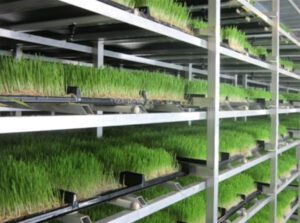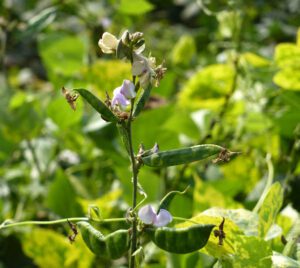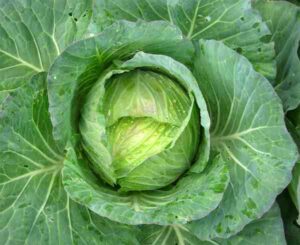Tomato farming is very common and popular throughout the world. It is an important commercial vegetable crop of many countries. And it is actually the second most important crop of world after potato.
Tomato is actually the edible berry of the plant Solanum lycopersicum (commonly known as tomato plant). The species originated in western South America and Central America.
The Nahuatl (the language used by the Aztecs) word tomatl gave rise to the Spanish word tomate, from which the English word tomato derived. It’s domestication and use as a cultivated food may have originated with the indigenous peoples of Mexico.[1]
Tomatoes are a significant source of umami flavor. And it is consumed in diverse ways. It is consumed raw or cooked, in many dishes, sauces, salads and drinks.
Tomatoes are fruits (botanically classified as berries), and are used as a vegetable ingredient or side dish. Many different varieties of tomato plant are widely grown in temperate climates across the world, with greenhouses allowing for the production of tomatoes throughout all of the year.
The tomato plants generally grow 3 to 10 feet in height. They are vines that have a weak stem that sprawls and typically needs support. Indeterminate tomato plants are perennials in their native habitat, but are cultivated as annuals. Exact size of the tomato varies according to the cultivar, with a range of 0.5 to 4 inches in width.
Generally, tomatoes are eaten raw or cooked. It is used in soup, juice and ketch up, powder. It is a rich source of vitamin A, C, potassium and minerals. Most of the tomato varieties are red when mature. But they also come in a variety of colors, including yellow, green, orange and purple. Many subspecies of tomatoes exist with different shapes and flavor.
However, here in this guide we are describing about tomato nutrition, advantages and ways of starting and operating a tomato farming business.
How to Start Tomato Farming Business?
Starting commercial or small scale tomato farming business is very easy and simple. The tomato plants generally require less caring and other management. So, you will be able to easily start and operate this business, even if you are a beginner.
The tomato plants generally grow well in almost all types of environment with the availability of full sun. And almost all types of soil are good for tomato farming.

You can easily start this business in your area. Here in this guide, we are trying to describe more information about tomato farming business from planting, caring to harvesting and marketing.
Step 1. Complete a Tomato Farming Training
Successful tomato farming requires proper training, skills, and knowledge. So, try to complete a training before starting commercial production.
Step 2. Make A Business Plan
A good and effective business plan helps to run your business smoothly. So, try to make a business plan before starting and try to include everything in your plan. You can ask for help from an expert if you are an absolute beginner.

Step 3. Select A Good Location
You have to select a very good location for starting your tomato farming business. It will be better if the selected land become fertile and well drained with exposure to full sun. The tomato plants generally grow well in all types of soil. Soil with pH 7 to 8.5 is considered ideal for tomato farming.
Sandy loamy soil with good moisture retaining, aeration and proper drainage system are perfect for best growth of the plants and higher fruit yields.
Step 4. Prepare the Soil for Tomato Farming
Before planting tomato plants, you have to prepare the soil perfectly. The tomato plants can be grown in a wide variety of soil types ranging from sandy loam to clay, black soil and red soil having proper drainage.
The plants grow well under well drained sandy soil with high organic content. The plants can tolerate moderate acidic and saline soil, but avoid cultivation in high acidic soils.
For preparing the soil for tomato farming, plough the land 4 to 5 times and level it. Add well decomposed cow dung and Carbofuron at the rate of 5kg or Neem cake at the rate of 8kg per acre at the time of last ploughing.
Soil solarization is carried out to destroy harmful soil borne pathogen, pest and organism. It can also be done by using transparent plastic film as mulch. This sheet absorb radiation and thus increases soil temperature and kill pathogen.
Step 5. Requirement For Tomato Farming
Tomato is a day-neutral plant, so it can widely found and grown in any season. In the southern plains where there is no danger of frost, the first transplanting is done in December to January, second in June to July and third in September to October depending on the irrigation facilities available.
In the northern plains, three crops are taken but in frost affected area Rabi crop is not fruitful. The Kharif crop is transplanted in July, Rabi crop in October-November and Zaid crop in February months.
Step 6. Best Time For Tomato Farming
Tomatoes actually can be grown throughout the year. And there are some tomato varieties available that grow and produce fruits throughout the year. You can actually start growing tomatoes after the frost disappears. You can plant seeds indoor prior to 6 to 8 weeks of the average last spring frost date, if you want to have an early harvest.
And where there is no fear of frost, the tomatoes can be grown any time, especially in the southern tropical areas. Although, you can’t expect good yield in excessive hot temperature. Around 22 °C temperature of the soil is considered ideal for germinating the tomato seeds.
Step 7. Choose the Right Tomato Variety
You have to choose the right variety for good yield and maximum profits., you have to choose the right variety. There are actually many different varieties of tomatoes available in the market to choose from. Some of these available varieties are of large size, some are small, some are of amazing colors, some are made for specific regions, some varieties are of bush type and some are dwarf. Some varieties take less time to harvest and some require around or more than 3 months.
Depending on your choice, location and purpose, choose the right variety for your business. You can consult with an existing farmer in your area for better recommendations.
There are many tomato varieties that are well-suited for commercial farming. Each of these varieties has its own unique characteristics that make it a great choice for commercial farming. Not all tomato varieties are created equal when it comes to commercial farming.
Some are better suited for this purpose than others. As a commercial tomato farmer, it is important to choose a variety that is well-suited to your needs and growing conditions. He, we will take a look at some of the best tomato varieties for commercial farming.
1. Roma Tomatoes
Roma tomatoes are a popular variety for commercial farming due to their high yields, disease resistance, and long shelf life. These oblong-shaped tomatoes are great for making sauces, pastes, and canned products, which makes them a favorite among commercial tomato farmers. They are also fairly easy to grow, which is another reason why they are so popular.
2. Beefsteak Tomatoes
Beefsteak tomatoes are another popular variety for commercial farming. They are large, meaty, and have a sweet flavor that makes them perfect for slicing and using in sandwiches or salads. They are also very versatile and can be used in a wide range of dishes. However, they require a lot of care and attention, which means that they may not be the best choice for beginner farmers.
3. Cherry Tomatoes
Cherry tomatoes are a great choice for commercial farming because they are small, easy to grow, and have a long shelf life. They are also very popular with consumers because of their sweet flavor and vibrant colors. They can be used in a variety of dishes, including salads, pastas, and pizzas. Due to their size, they are also great for snacking on the go.
4. San Marzano Tomatoes
San Marzano tomatoes are another popular variety for commercial farming. They are a type of plum tomato that is popular in Italy, where they are often used for making tomato sauce. They are also popular in the United States, where they are used in a variety of dishes. They have a sweet, rich flavor and are known for their meaty texture.
5. Heirloom Tomatoes
Heirloom tomatoes are a type of tomato that has been passed down from generation to generation. They are often grown by small-scale farmers, but they can also be grown on a larger scale. They are popular with consumers because of their unique flavors and colors. However, they can be difficult to grow and require a lot of care and attention.
Step 8. Purchase Tomato Seeds
Collect or purchase seeds, after selecting the good variety for your business. Tomato seeds are easily available in the market. So, you will probably be able to purchase the seeds from your local market. You can also consider ordering the seeds online. Today, there are some seed suppliers with online stores.
Tomato Seeds Per Acre
You will need about 100 grams of seeds for planting an area of around one acre.
Step 9. Planting
You can plant either seeds or seedlings when the soil is warm. It is good to start in pots or container and then transplant. The seedlings will be ready for transplanting when they are of approximately 6 inches height. Hardening off transplants is very important if you plant seeds indoor. So harden off transplants for a week before planting in the garden.
Set the transplants outdoors in the shade for a couple of hours for the first day, for hardening off transplants. And then gradually increase the amount of time your plants are kept outside each day. It will be better if you can place tomato stakes or cages in the soil, during the time of planting.
Depending upon variety, uses and it’s growth habit, use spacing of 60x30cm or 75x60cm or 75x75cm. For dwarf variety use spacing of 75cm x 30cm and for rainy season use spacing of 120-150 x 30cm.
Step 10. Caring for Tomato Plants
The tomato plants generally require less caring and other management. Although it is important to take additional caring for good yield.
Caring the tomato plants is very easy and simple. Here we are trying to describe more information about the caring process for commercial tomato farming business.
Fertilizing
The tomato plants are heavy feeders, so apply adequate fertilizers. At the time of land preparation, apply well rotten cow dung@10ton/acre and mix well in the soil. Apply fertilizer dose of N:P:K @60:25:25kg/acre in form of Urea@130kg/acre, Single Super Phosphate@155kg/acre and MOP@45kg/acre.
Apply half dose of Nitrogen, full dose of Phosphorus and Potash applied as basal dose, apply it before transplanting. 20 to 30days after transplantation apply remaining 1/4th dose of nitrogen. Two month after transplantation, apply remaining dose of Urea.
Watering
Apply adequate irrigation during winter with an interval of 6 to 7 days. And in summer months, apply irrigation with an interval of 10 to 15 days depending upon soil moisture.
Mulcing
Mulcing is very important for retaining moisture into the soil. It is also beneficial for controlling weeds from the field.
Controlling Weeds
Do frequent weeding, hoeing and earthing up and keep field weed free till 45 days. If weed left uncontrolled then it will reduce crop yield upto 70 to 90 percent.
Two to three days of after transplantation take spray of Fluchloralin @800ml/200Ltr water as pre-emergence weedicide. If weed intensity is high, take post emergence spray of Sencor@300g/acre. Mulching is also an effective way to reduce soil temperature along with weed control.
Pruning
Prune the plants by pinching off side stems (suckers), if you are using stakes and keep only a couple of branches.
Step 11. Control Pests and Diseases
Like any plant, tomatoes are susceptible to pests and diseases that can harm their growth and ultimately affect their yield. Here, we’ll discuss some of the most common tomato pests and diseases, as well as how to prevent and treat them.
Common pests affect production in tomato farming are aphids, hornworms, whiteflies etc. And common diseases affect production in tomato farming business are early blight, late blight, veticillium wilt etc. Consult with an expert in your area to know about the controlling methods of these pests and diseases.
Step 12. Harvesting
Depending on the variety, most of the plants will start yielding by 70 days after transplantation. Harvesting is done depending upon purpose like for fresh market, long distance transport etc. Mature green tomatoes, 1/4th fruits portion gives pink color are harvested for long distance markets.
Almost all fruits turn into pink or red color but having firm flesh are harvested for local markets. For processing and seed extraction purpose, fully ripe fruits with soft flesh are used.
Step 13. Marketing
Marketing tomatoes is very easy. You will probably be able to easily sell your products in the local market. You can market either raw tomatoes or some products made from tomatoes. Although, you should set your marketing strategies before starting this business.
These are the common steps and ways for starting and operating a successful tomato farming business. It’s very easy and simple, even the beginners can start this business. Hope this guide has helped you. Good luck and many God bless you!







Thank you very much! This is more than enough